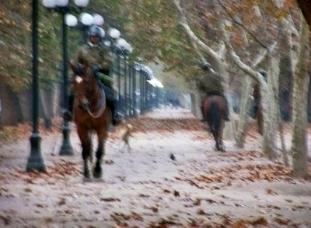

x
| A little grey walking within some cloaking field where he appears to be invisible to the physical sight. |
| Look to the left of the x and you will see a tree nymph camafloging himself into the tree as he sits in the fork of the tree watching me walk by . The blur is caused from the moving energy of the vortex that the entity is in. |
| The Little People Back to Little People Home Page Mary Sutherland Home Page |
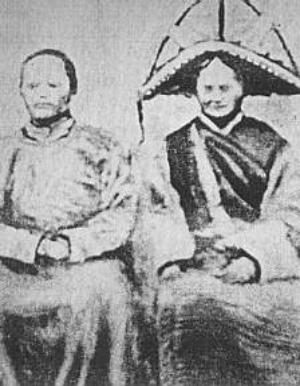
| THE CHINESE ROSWELL Date & Location: 10,000 BC Byan-Kara-Ula mountains China Vallee Classification:CR3-333 Tangibile Evidence: Multi-Witness, Physical Evidence (The skeletons, and the discs), Local legend of a tribe called the dropas who "fell from the sky", Living tribe found matching the Dropas description and history. Click Here for Full Story |
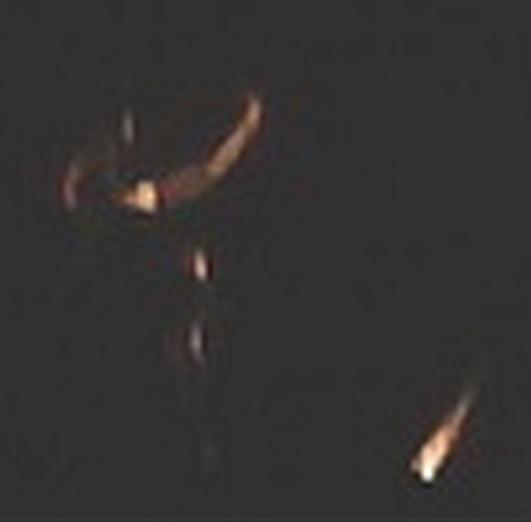
| We photographed this faerie in the woods. It looks like he/she is performing a dance. Photographed by Mary Sutherland 2001 |
| Two leprechauns photographed in the Burlington Woods by Mary Sutherland |
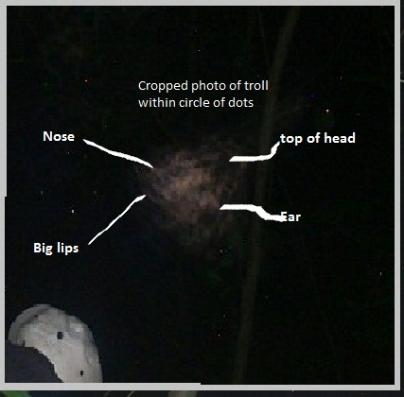
| A troll photographed in the woods by Mary Sutherland |
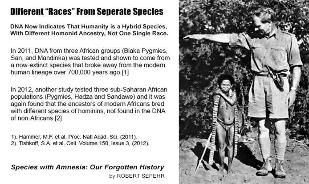
| Caucasian and Asian populations have up to 4 percent DNA stemming from the Neanderthal species – a hominin that went "extinct" more than 20,000 years ago. About 13% of the sub-Saharan African gene pool comes from earlier pre-modern hominins, including some that split from the ancestors of anatomically modern humans over 1.2 million years ago, not found in the DNA of non-Africans. Credit: Robert Sepehr |
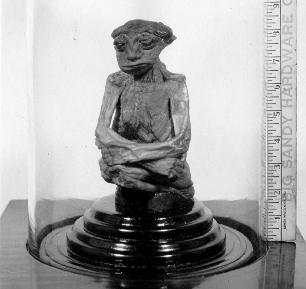
| USA - Pedro – The Missing Mini-Mummy of Wyoming http://karlshuker.blogspot.com/2016/06/remembering-pedro-missing-mini-mummy-of.html Because other articles about this tiny mummy have been deleted from the internet in the past, I copied the text below so that it would not be lost like other deleted information. The source article (linked above) has many other photos Some of the text from article: Pedro's extraordinary modern-day history may have begun one day in October 1932 (but see later for an alternative claimed date), when gold-prospectors Cecil Main (spelt 'Mayne' in some accounts) and Frank Carr blasted a hole through the wall of a ravine in the San Pedro Mountains, about 65 miles southwest of the city of Casper, Wyoming - and made a momentous discovery. The wall had been hiding a small, room-like, hitherto-sealed cavern, which contained a ledge, 2.5 ft off the ground. And sitting on that ledge, in cross-legged pixie-like pose, with its arms folded across its chest, was the mummy of a diminutive humanoid figure, with a sitting height of less than 7 in and a total height of only 14 in. Sporting a tanned if wrinkled bronze-coloured skin, barrel-shaped body, well-preserved penis, large hands, long fingers, low brow, very wide mouth with large lips, and broad flat nose, this strange figure resembled a smirking old man, who seemed almost to be winking at its two amazed discoverers, because one of its large eyes was half-closed. Nevertheless, it was evident that this entity had been dead for a very long time, and its death did not appear to have been a pleasant one. Its head was abnormally flat, and was covered with a dark gelatinous substance - later examinations by scientists suggested that its skull may have been smashed by an extremely heavy blow, and the gelatinous substance was congealed blood and exposed brain tissue. Also, some reports claim that it had a broken clavicle (or scapula in certain others), as well as some broken vertebrae, and pointed "front teeth". Due to its mountain provenance, this remarkable specimen was soon dubbed Pedro by the media, following its discovery's announcement in a report by the Casper Tribune-Herald newspaper on 21 October 1932 (but once again see later for an alternative claimed date). When Main and Carr brought Pedro back home with them to Casper, it was widely denounced as a hoax, though some locals believed that it may indeed be one of the Little People long deemed in traditional lore to exist in the mountains. Carr died shortly afterwards, and in April 1934 Main sold Pedro to Homer F. Sherill from Crawford, Nebraska, who subsequently exhibited it encased inside a large glass dome as a curio at a circus there (as well as at several sideshows elsewhere), where it was seen by Eugene Bashor in 1936. Although he was only a boy at that time, Bashor was so fascinated by Pedro's enigmatic appearance that he went on to become a leading, longstanding investigator of North American mini-mummy and littlefoot reports. Sherill owned Pedro for at least 7 years, but somehow this anomalous little entity subsequently turned up at Jones Drug Store in Meeteetse, a small town in Park County, Wyoming, where it remained on display until it was spied there one day in the mid-1940s by Ivan Goodman, a used car salesman from Casper, who reputedly purchased it from the drug store's owner, Floyd Jones, for several thousand dollars. Thereafter, Goodman utilised Pedro's eyecatching appearance to attract people to his car lot, and for which it became an unofficial mascot, with images of it being placed by Goodman in advertisements for his auto dealership. Moreover, it was during its period of ownership by Goodman that Bashor saw Pedro for a second time, in 1948, sitting on Goodman's desk. In 1950, Goodman permitted some interested scientists to examine his 'mascot' in an attempt to uncover its true nature. The most detailed examination, including an x-ray analysis, was conducted by anthropologist Dr Henry ('Harry') Shapiro from New York's American Museum of Natural History. According to a Casper Tribune-Herald report of 5 March 1950, this study confirmed that Pedro was not a fake but did indeed contain a complete if minuscule skeleton, a fully-fused skull (seemingly verifying that it was an adult humanoid, not an infant), plus a full set of teeth. Some accounts have even claimed that Shapiro opined that Pedro had been approximately 65 years old upon death; others, conversely, alleged that he had identified it as an infant - yet another source of controversy regarding Pedro. In that same newspaper report, Goodman himself was quoted as stating: "After an exhaustive study by the scientists it was agreed that it was the only specimen known of a human race of that type which perhaps dated back a million years". However, such a dramatic claim as this seems unlikely to have been made by the scientists, so it may well have originated from the canny Goodman instead - possibly as an additional means of publicising his car business. Unfortunately, there is no way of knowing for sure, because Goodman died later that same year. Just before his death, Goodman loaned Pedro to Leonard Wadler, a New York businessman, for study purposes. However, it was never returned to Goodman's family, and Wadler moved to Florida soon afterwards, allegedly dying there during the 1980s. But what happened to Pedro? No-one knows, because no-one has been able to trace Wadler's precise movements and whereabouts once he had acquired Pedro. One report claimed that Wadler's family was contacted by (unnamed) investigators sometime after his death enquiring where Pedro may now be, but that they had no idea either. Incidentally, back on 13 November 1936 one of Pedro's original discoverers, Cecil Main, had signed an official affidavit containing what he claimed to be the true facts behind their notable find, and which was sworn in Scotts Bluff County, Nebraska, and officially recorded in Hot Springs County, Wyoming, on 16 August 1943. Oddly, however, this document contains what would appear to be some glaring inconsistencies with other versions of events. In it, Main stated that Pedro had been discovered by them in June 1934. Conversely, as already noted in this present ShukerNature article, a report documenting that event had allegedly been published in the Casper Tribune-Herald on 21 October 1932, followed by additional articles published by this same newspaper in that same year, at least according to Brendan Burke's above-mentioned Casper Star-Tribune report from 2005. Here is what Burke wrote in it: “Mayne was prospecting for gold near Pathfinder Reservoir when an explosion he detonated revealed a small cave, according to a Oct. 21, 1932, article in the Casper Tribune-Herald. Inside the cave Mayne found the mummified remains of what looked like a tiny human.” Debate about the mummy's nature started soon after it was found. Some said it was a hoax. Others said it was the mummified remains of a baby. And others said it was one of the little people spoken about in Indian legends, according to Casper Tribune-Herald stories from 1932. So if these supposed Casper Tribune-Herald reports from 1932 do indeed exist, then Main's claimed date of June 1934 was clearly incorrect. Main also alleged in his affidavit of November 1936 that Pedro was "now owned by Homer F. Sherill, and located in the Field Museum in Chicago, Illinois". Yet once again, contemporary reports claim that Main had actually sold Pedro to Sherill in April 1934 (i.e. two months before it had even been discovered, according to the discovery date given in Main's affidavit). Moreover, as noted by Rebecca Hein in an undated online article concerning Pedro accessible within the WyoHistory website: “Archivist Armand Esai notes that the Field Museum has no record of the mummy's presence during that time. The item still could have been there on loan or for identification, but because it was not part of the museum's official collection, the mummy was not listed in the records.” As seen, the discrepancies between different accounts as to whether Shapiro had (or had not) claimed that Pedro exhibited certain adult characteristics are by no means the only contentious, contradictory aspects of Pedro's post-discovery history. Fortunately, at least Pedro's original x-ray plates are still on file and thus confirmed, as are some vintage photographs of it, including those presented here. Moreover, not long after Pedro's initial discovery by the two prospectors, a Mexican shepherd called José Martinez reputedly found another mummy and six separate skulls on a ranch in the same vicinity. After soon suffering a number of mishaps, however, Martinez considered them to be jinxed, so he swiftly replaced them where he had found them. Other mini-mummies have also been reported over the years from elsewhere in the U.S.A. One of the most noteworthy of these was a 3- ft-tall, red-haired specimen discovered on a ledge in Kentucky's famous Mammoth Cave, and exhibited widely during the 1920s, which seemed to be only a few centuries old (later radiocarbon-dating studies, however, revealed that it was 3,000-4,000 years old). During 1922, sheep-herder Bill Street claimed to have found several small skulls and whole mummies in Montana's Beartooth Mountains, but their present whereabouts are unclear. Two young men on a day off from the Civilian Conservation Corps in 1933 came upon a dead pygmy with sharp teeth in Wyoming's Wind River Mountains, but both died soon afterwards, and others who saw it allegedly died from severe illnesses. In 1969, author John 'Ace' Bonar visited orthopaedic specialist Richard Phelps in Casper to see the preserved head of a mysterious tiny humanoid that he was displaying at that time in his shop. Bonar learnt that the head had originally been taken from a cliff near Wyoming's Muddy Gap. After Phelps's death in 1980, his daughter donated the preserved pygmy head to the University of Wyoming in Laramie, where it is still said to be today. According to Bonar, the husband of Winnie Cardell from Alcova, Wyoming, also owned a mini-mummy - until he loaned it to a college professor, who never returned it. A specimen closely resembling Pedro, meanwhile, attracted media attention in January 1979 when it was loaned to Californian antique appraiser Kent Diehl of San Anselmo for examination. Just under 1 ft long, with an indentation at the back of the head indicating brain injury as the cause of death, the mummy was supposedly found in Central America during 1919, but Diehl would not publicly identify the family from Marin, California, that presently owns it. Some researchers consider Pedro to have been a grossly-malformed human child or foetus - possibly with anencephaly, a teratological condition in which the brain has not developed fully (if at all) during foetal maturation. This latter identity was proposed for Pedro by anthropologist Prof. George W. Gill from the University of Wyoming after examining photos of it first shown to him by his students in 1971. Moreover, in 1994, after appearing with Eugene Bashor on an episode of the TV show Unsolved Mysteries hosted by Robert Stack and dealing with Pedro, Gill was contacted by a rancher from Cheyenne (Wyoming's capital) claiming to own a mini-mummy. This one proved to be a tiny blond-haired girl, only 4 in high, and dubbed Chiquita, which one of the rancher's (great-)grandfathers (reports differ) had purchased from a sheep-herder in or around 1929 and which had been kept ever since inside a trunk in his home's attic. When Gill examined Chiquita and DNA analyses were conducted upon it, assisted by the Denver Children's Hospital, he found that it was indeed an anencephalic Native American infant (examination of a femur removed from this mini-mummy had revealed that its distal ends had not closed, a sign of infancy). In their book Mountain Spirit: The Sheep Eater Indians of Yellowstone (2006), Lawrence L. Loendorf and Nancy M. Stone stated that radiocarbon dating tests had indicated that it was around 500 years old. With regard to Pedro, conversely, if its adult characteristics allegedly revealed by Shapiro during his 1950 study were genuine, and not erroneous identifications (or erroneous claims made by the media), they would seem to contradict an anencephalic status for it. (Incidentally, one report read by me claiming that Gill had studied Pedro's x-rays directly after Shapiro had conducted his own 1950 study of them, and that it was Shapiro who had personally given the x-rays to Gill at that time, is clearly in error, because in 1950 Gill was still only a youth.) Also, why was Pedro placed on the ledge and then sealed away inside that small room-like cavern within the Pedro Mountains? After all, this does seem not only a very purposeful but also a very strange and extreme action for anyone to take with merely a malformed infant. And who placed it there anyway? Source article: REMEMBERING PEDRO – THE MISSING MINI-MUMMY OF WYOMING http://karlshuker.blogspot.com/2016/06/remembering-pedro-missing-mini-mummy-of.html Photo: Pedro inside his glass dome, with ruler to show size |
| The Little People Exploring the Unknown with Brad and Mary Sutherland |
| Brad and Mary Sutherland 248 Carver Street Winslow, Illinois 61089 815 367 1006 |

| Allow me to Introduce Myself .... Click Here |
Help Support Mary Sutherland's Work by sending a Donation. Thank You. |
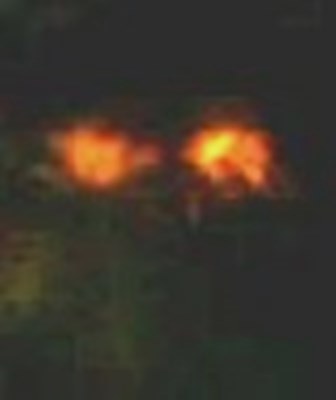
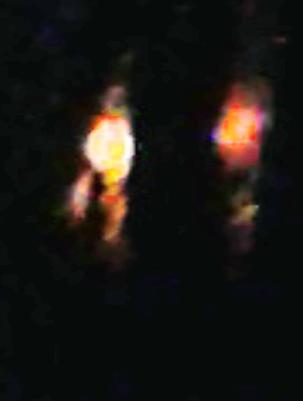
| Two more leprechauns photographed by Chris Riley |
